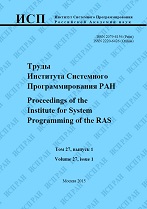|
Building modular real-time software from unified component model
K. A. Mallachievab, A. V. Khoroshilovacbd
a Lomonosov Moscow State University
b Institute for System Programming of the Russian Academy of Sciences
c Moscow Institute of Physics and Technology
d Higher School of Economics
Abstract:
Modern real-time operating systems are complex embedded product made by many vendors: OS vendor, board support package vendor, device driver developers, etc. These operating systems are designed to run on different hardware; the hardware often has limited memory. Embedded OS contains many features and drivers to support different hardware. Most of the drivers are not needed for correct OS execution on a specific board. OS is statically configured to select drivers and features for each board. Modularity of OS simplifies both configuration and development. Splitting OS to isolated modules with well-specified interfaces reduces developers’ needs to interact during joint development. The configurator, in turn, can easily compose isolated components without component developers. We use formal models to specify components and their composition. Formal model describes the behavior of components and their interaction. Usage of formal models has many benefits. Models contain enough information to generate source code in C language. Our model is executable; this allows configurator to quickly verify the correctness of component configurations. Moreover, model contains constraints on its parameters. These constraints are internal consistency or some external properties. Constraints are translated into asserts in generated source code. Therefore, we can check these constraints both at model simulation and at source code execution. This paper presents our approach to describe such models at Scala language. We successfully tested the approach in RTOS JetOS.
Keywords:
components, modularity, RTOS, formal models, code generation.
Citation:
K. A. Mallachiev, A. V. Khoroshilov, “Building modular real-time software from unified component model”, Proceedings of ISP RAS, 30:3 (2018), 135–148
Linking options:
https://www.mathnet.ru/eng/tisp330 https://www.mathnet.ru/eng/tisp/v30/i3/p135
|

| Statistics & downloads: |
| Abstract page: | 107 | | Full-text PDF : | 105 | | References: | 12 |
|




 Contact us:
Contact us: Terms of Use
Terms of Use
 Registration to the website
Registration to the website Logotypes
Logotypes








 Citation in format
Citation in format 